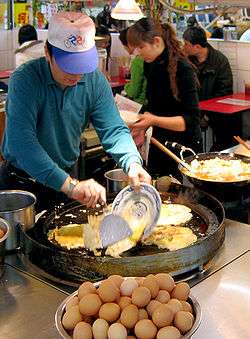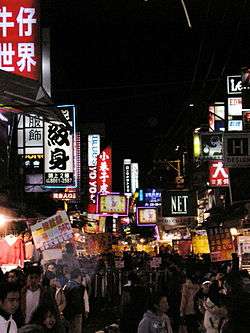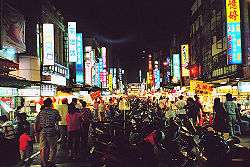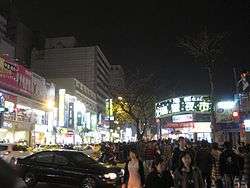Night markets in Taiwan
Night markets in Taiwan are street markets in Taiwan that operate in urban or suburban areas. They are similar to those in areas inhabited by ethnic Han, such as Southeast Asia. A few, such as Huaxi Street Tourist Night Market, (or Snake Alley) utilize purpose-built marketplaces but most occupy either sidewalks (pavements) adjacent to streets or entire streets that are normal thoroughfares by day. Some night markets in smaller side streets or lanes feature retractable roofs. Most of the markets operate daily and feature a mixture of individual stalls hawking clothing, consumer goods, xiaochi (similar to snacks or fast food), and specialty drinks. The atmosphere is usually crowded and noisy with hawkers shouting and fast-paced music playing over loudspeakers. Taiwan Night Markets changed from small local gatherings to noisy streets lined up with vendors. These vendors have to adhere to some laws set by the Taiwanese Government. There are vendors selling food in some of the most famous Night Markets all around Taiwan. There are many night markets in Taiwan.
History
The concept of the Night market traces its roots back to the Chinese Tang dynasty. The Tang Dynasty government put strict sanctions on Night Markets and their operations in A.D. 836. Towards the end of the Tang Dynasty, economic expansion led to less state regulation and restrictions being lifted on Night Markets. During the Song Dynasty (960-1279), Night Markets played a central role in Chinese nightlife. These markets were found in corners of large cities. Some stayed open for twenty- four hours. Song period Night Markets are also known to have included restaurants and brothels due to being frequently located near business districts and red light districts.[1]
Taiwanese Night Markets started as local markets that operated in urban sites. Most Night Markets started as small gatherings in street corners or in temple plazas. These markets were joined by retailers who sold handicrafts and traditional medicine. One example of a Night Market Network is Taipei. Small gatherings of night vendors lined up the streets of Taipei, but still the city was not classified as a Night Market. Taipei was not known to be prosperous until after World War II. Starting in the 1950s, Night Markets formed in Taipei's old urban areas and later settlements were set up across the city's edges. In the 1970s, Night Markets spread into new suburbs and manufacturing areas. There were also traveling periodic Night Markets that could even be found in rural towns. By the 1980s, anyone could buy a full range of goods even in a remote area.[2]
In the 1950s and 1960s, migrant urban workers made up a large base of the Night Market's customers. The vendors created simplified versions of banquet dishes and served xiaochi foods. The names of the towns came from the dishes they served. The serving of xiaochi foods attracted Taiwan's local elite. Stories were formed of how well-known politicians and intellectuals visited Night Market stalls.[2]
Night Markets started to embody the local and the global modern popular culture because of commercial industries. Because of the global recession in the 1970s, canceled imports created more opportunities for vendors selling light industry and family made goods. This was due to more products becoming available to local markets. Night Marketing Networks were formed and sold Taiwan's light industry goods.[3]
Because of the prosperity of the Night Markets, some traditional businesses were replaced by higher quality garment and shoe stores in the 1980s. The energetic Night Markets were known during this period where neon signs, loud music and light displays were used to attract customers. The new replaced the old, cafeterias instead of restaurants, gift shops instead of sundry shops, sportswear outlets instead of low quality garment stores. At Taiwan's stock market surge, chains started opening franchises that were located in or near the Night Markets. These included fast food outlets such as McDonald's and convenience stores such as 7-Elevens, which were then followed by garment stores. This transformation continued in the 1990s, when chains who sold higher grade merchandise replaced individually owned businesses.[3]
Night Markets changed from places that sold traditional snack food and handicrafts to modern centers of popular culture. Markets rapidly responded to new trends by producing their own versions of popular goods, especially in the 1990s, when copyright and intellectual property laws were only loosely enforced. These counterfeit items that now flooded the market attracted young customers. In recent years, these laws are now more strictly enforced so counterfeit items are usually found in traveling Night Markets. The Night Markets are now known for not personifying Taiwan as it once did. The Night Market transformed to accommodate the modern capitalist economies of present day.[4]
21st century
Night markets in Taiwan have become famous for their xiaochi, an important category of Chinese food which literally translates to "small eats". Served in portions similar to Spanish tapas, these dishes are often served as carry-out items, but many sellers provide small folding tables and stools for customers who would like to sit while they eat. These dishes are offered at low prices, usually around $30 to $50 NTD (≈$1–$1.75 USD). Visitors who expect to eat enough to be full during a trip to the night market will usually spend around $100NTD - $300NTD (≈$3–$10 USD). Most night markets also have some small restaurants, which provide a number of simple courses that allow people to finish a full meal without having to eat their way through the entire market.
Though some of the xiaochi foods available will change from year to year with passing fads, certain xiaochi foods such as oyster omelets, chicken shawarma, and stinky tofu persist and have become staples in many night markets. Sometimes, the night markets of a city, or even just one particular market within that city, become well known for a certain type of food that is unique to the area, or prepared particularly well there. For example, Tainan has become known for its ta-a noodles and "coffin cakes", bread baked into the shape of a stuffed, hollowed out coffin. In Taipei, the Shilin Night Market features a particular store, which is well known for serving tasty fried chicken breast in large portions and for a low price. There is also the iron eggs from Tamsui.
In recent years, many of the night markets have become popular tourist destinations among sightseeing foreign travelers. It is common to see many travelers with cameras, snapping photographs amidst the crowds (and of the crowds) within the streets. Some of the night markets, such as the Shilin (at Yuanshan, Taipei) and Shida night markets (next to National Taiwan Normal University) are among the first places that Taiwanese students will bring international students for a cultural experience.
In addition to food, night markets feature various forms of entertainment and a lot of shopping. Numerous products for sale include clothes, bags, shoes, trinkets, kitchen items, etc. Some night markets will have areas that are dedicated to certain products such as clothes, which are sold both by street vendors in the 100 to 300 NTD (≈$3–$10 USD) range and in the small storefronts lining the streets usually priced slightly higher in the 300 to 500 NTD range. These shops are often open during the day as well, especially during the afternoon before the evening rush. Carnival-style games are typically available to play for the price of a few coins. The night market in Tamsui is especially well known for featuring traditional carnival games such as balloon shooting, net fish, shooting marbles, and an assortment of mini games that could only have otherwise been seen many years ago.
Vendors
Vendors practice a type of small scale entrepreneurship run, for the most part, by family. The Vendors are recognized and protected by law. They are required to pay taxes and have licenses. Merchants are managed through their Night Market committee. The consent of the committee is required to acquire a license. Tourist Night Markets are classified as between formal and informal businesses. It provides a way for local people to take part in the Taiwanese tourist industry.[5]

Most famous night markets
Northern Taiwan
Raohe Street Night Market
Running six hundred meters from Fuyuan Street to Ciyou Temple, Raohe Street Night Market is located in the Taipei's Songshan District on Raohe Street. In Taipei, it was the second Night Market to be considered a tourist destination.[6]
Shilin Night Market
Shilin Night Market is one of the most famous and largest night markets in Taiwan, located in Taipei. The night market first opened in 1899, and it is now famous for its various eateries selling of authentic Taiwanese snacks. The night market wakes up in the late afternoon and early evening, and is soon packed with people, especially on holidays. Locals often come with family and friends to eat, browse and look for great bargains. The market is along the route to the National Palace Museum, making it a good next stop for museum visitors. Contrary to the misleading names, the night market is located right across the street from Jiantan Metro Station, rather than the consecutive Shilin Metro Station.
Some of the most famous snacks include deep-fried chicken breasts (雞排; jīpái), kebabs, spring onion pancakes, pan-fried dumplings, grilled Taiwanese sausages, small sausage in large sausage, hot pot, oyster omelets, fresh squid, and pork or fish thick soups. Popular drinks include pearl milk tea, Chinese herbal teas, and juices made with fresh local fruits and vegetables.
The Night Market consists of two different sections. One section is the durable goods section, which is surrounded by the Yang Ming Cinema on Anping Street. The other section is the food section, and it consists of food vendors on the opposite side of the Jiantan Metro Station.[6]
Linjiang Night Market
The name, "Linjiang Night Market", is unfamiliar to some Taipei residents who better know the Night Market as "Tonghua Street Night Market." This Night Market has been known for some time as a popular shopping area.[6] It is located in Da'an District near Taipei 101 and the neighboring Xinyi District. Centered around one street, it is a popular destination for cheap meals while being lighter on the shopping aspect. The neighboring street has several pet shops as well.
Shida Night Market
Located near National Taiwan Normal University, known to locals as Shida, the student presence cultivates a casual and trendy atmosphere. Beyond the usual selection of street food, the shopping is notably more boutique-oriented compared to other popular spots. However, the night market has shrunk in recent years due to neighborhood complaints and rezoning of the area.[7] Now mostly a place for locals, it can be accessed by the Taipower Metro Station.
Keelung Temple Night Market
The Keelung Temple Night Market (基隆廟口夜市; Jīlóng Miào Kǒu Yèshì) night market was started to serve the needs of the many worshipers who came to the popular Dianji Temple (奠濟宮; Diànjì Gōng) to pray for fortune, good luck, and health, or to seek answers to their problems. The night market centers on the neighboring area of the temple. There are over sixty registered food stalls here. One of the most famous snacks at the night market is Dingbiancuo (鼎邊趖), which is a rice noodle soup made with mushrooms, bamboo shoots, dried tiger lilies, dried shrimp, oysters and shredded pork. Other famous snacks include butter crabs, eel stew and Taiwanese tempura. Because Keelung is a port city, fresh seafood is another feature of the night market. A Keelung specialty and particularly popular drinks is Paopao Ice, which is ice shaved and beaten up into fine, smooth, snow-like texture and then flavored with fruity jams and nuts.
Central Taiwan
Fengjia Night Market
Fengjia Night Market is located in Xitun District, Taichung along Fuhsing Road and Wen Hua Road. It extends along those two roads and even touches Chijian Night Market. This Night Market is also known as the Wenhua Night Market.[6] It is just near Feng Chia University and Chinese Institute of Technology. Students from these two schools make up a good part of the customers here. During the weekday evenings there are usually around thirty to forty thousand shoppers, while on the weekend’s Feng Chia Night Market is best known for its prices and variety. Altogether, there are an estimated 15,000 shops, restaurants and stalls in the market. All kinds of fashionable clothing, accessories, toys, electronic products and the latest music CDs and DVDs are sold in shops or stalls while food stalls and restaurants offer snacks from around the world. In addition a lot of snacks have been invented locally by the food stall or restaurant owners. A lot of innovative snacks now seen in Taiwan's other night markets were originally created in FengChia Night Market:, which were deep-fried salty and crispy chicken ribs (see Taiwan fried chicken), cheese potatoes, pearl milk tea, 4-in-1 combo juice and Japanese-style chicken ribs are some famous examples.
Tunghai Night Market
This Night Market has been known as one of the most prosperous areas. Many would not guess this due to the fact that it is located on the edge of Taichung and about twenty minutes from the city center. The Night Market has grown from just a few shops to a whole commercial district that extends from the Tunghai University.[6]
Fengyuan Myaudung Night Market
People used to gather around the local Tzu-Chi Temple where merchants served the crowds of people that encircled the courtyard and the temple. Room was left on the side of the temple during an expansion project and was leased out to vendors. The Fengyuan Myaudung Night Market was formed and continues to serve the residents and tourists of Taiwan.[6]
ChingCheng Night Market
ChingCheng Night Market is located in Changhua near Ching Cheng High School. In the past, the owners tend to park their stands on the Lin Sen Road, and there is a famous traditional Chinese physician live around the corner,who called Gao Sai. Thus, ChingCheng Night Market also known as GaoSai Night Market.
Southern Taiwan
Liouhe Night Market
As early as the 1950s, food stalls started to gather in the vacant lot near Dagangpu in Kaohsiung's Sinsing District (高雄大港埔新興區; Gāoxióng Dàgǎngbù Xīnxīng Qū). It was first called Dagangpu Night Market (大港埔夜市; Dàgǎngbù Yèshì), since then, the market has grown over the decades and is now called Liouhe Night Market.
The market is best known for its numerous eateries. Due to its location a short distance from Kaohsiung Railway Station, in the daytime it is a thoroughfare, while in the evening it transforms into a big open-air shopping arcade. The stalls here mostly offer foods, snacks or games and, some sell daily commodities and clothing. Dozens of steak houses can be seen clustered here and the key selling point is low prices, targeting family customers. Because Kaohsiung is in the tropical zone and near the sea, stalls or shops selling all kinds of ice lollies, flavored crushed ice and cold drinks are also very popular. Fresh seafood is another specialty. This night Markets grew in the 1940s to 1950s to be known as one of Kaohsiung's most popular night market. The venue is only open to pedestrians.[6]
Ruifeng Night Market
Situated in northern Kaohsiung, Ruifeng Night Market is known of its large variety of snacks at low prices. It is usually considered the most popular night market among locals.
Kaisyuan and Jinzuan Night Markets
The two adjacent night markets, Jin-Zuan Night Market and Kaisyuan Night Market opened in 2013, and were said to be the two largest in Taiwan, but has since shrank 60% in size. They feature eateries more commonly found in restaurants, such as teppanyaki and conveyor belt sushi, as well as unique designs like road signs and a fancy restroom.
HuaYuan (花園) Night Market
Situated in Northern District Tainan, at the Junction of He-Wei Road and Hai-An Road; it is also voted one of the best night markets in Taiwan. Open on evening of Thursday, Saturday and Sunday. Varieties of local and foreign hawker food, attire, entertainment were among the market's attraction.
Eastern Taiwan
Nanbin Night Market
During the day the area is crowded with beach goers, but at night it turns into an active Night Market. It is located in Nanbin Park. There are carnival games that go on every night.[6]
Luodong Night Market
Luodong Night Market is known as one of the busiest and most popular for food. Vendors gather around Chong Shan Park and sell goods to the masses.[6]
Dongmen Night Market
Once a small area, it has grown around the surrounding area to form a key tourist destination. It is located under the Yilan Donggang Bridge along Hemu and Shenghou Road.[6]
See also
| Wikimedia Commons has media related to Night markets in Taiwan. |
Notes
- ↑ Yu (2004), p. 134.
- 1 2 Yu (2004), p. 135.
- 1 2 Yu (2004), p. 136.
- ↑ Yu (2004), p. 137.
- ↑ Hsieh, An-Tien; Chang, Janet (February 2006). "Shopping and Tourist Night Markets in Taiwan". Tourism Management. 27 (1): 138–45. doi:10.1016/j.tourman.2004.06.017.
- 1 2 3 4 5 6 7 8 9 10 "Taiwan's Night Markets". Ministry of Foreign Affairs. Archived from the original on 2012-06-13. Retrieved 2012-10-23.
- ↑ "Shi-Da Night Market (師大夜市)". Guide to Taipei.com. Retrieved 14 July 2016.
References
- Yu, Shuenn-Der (2004). "Hot and Noisy: Taiwan's Night Market Culture". In Jordan, David K.; Morris, Andrew D.; Moskowitz, Marc L. The Minor Arts of Daily Life: Popular Culture in Taiwan. Honolulu: University of Hawaii Press. ISBN 9780824864866.


